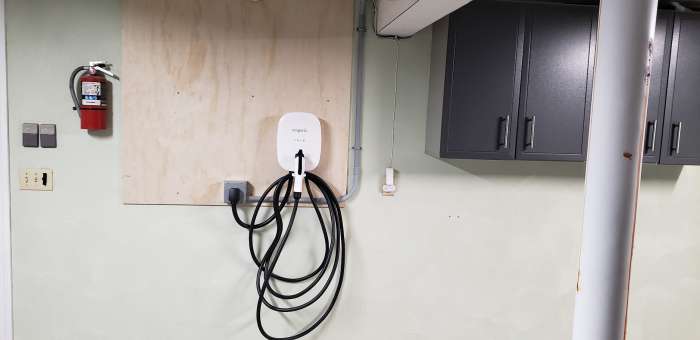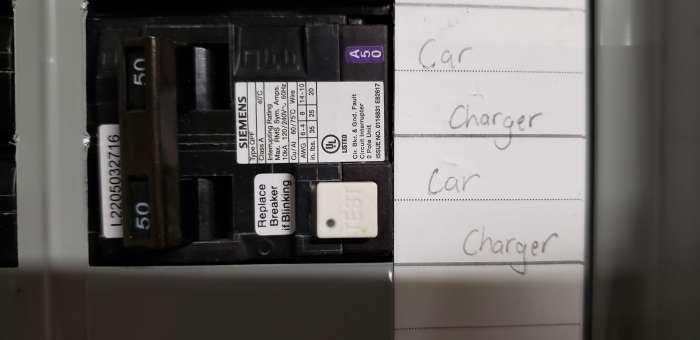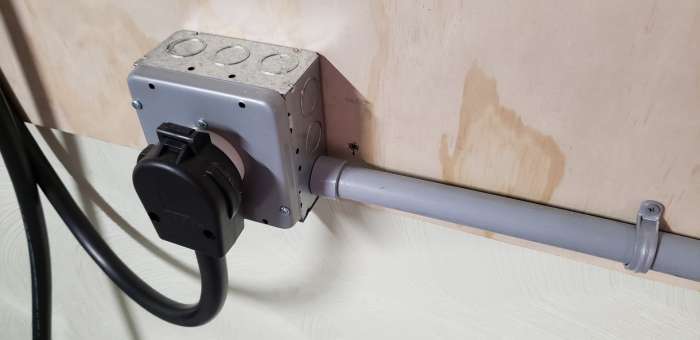As electric vehicles become more common and ownership expands, so too will home EV chargers. Look at any poll related to how EV owners charge, and you will see that most EV owners charge most of the time at home. Many owners who we have polled almost never charge anyplace by in their own garage. For this reason, we felt it was important to shed some light on an easily-avoidable EV charger installation problem many owners run into.
Related Story: Tips From a Veteran - What To Know Before You Install A Home EV Charger

Your author has upgraded the electrical system in several of his homes and installed numerous garage-mounted EV chargers. During the most recent installation, I chatted with two town electrical inspectors who work in Metro Boston. I asked both, “What is the most common problem you uncover during an inspection of a new EV charger circuit?” Both had the same answer and responded, "Failure to install proper protection on a new outlet in the garage.”

The mistake relates to what is called a ground fault circuit interrupter, GFCI. This is a safety device intended to prevent a person from electrocution by accidentally becoming a path to ground for a live circuit. If your home is modern, all of your bathroom and outside outlets have GFCI protection, as well as some in your kitchen, basement, and garage areas.
The mistake that homeowners )and some careless electricians) run into is not installing a GFCI-protected circuit breaker when they opt to use an outlet into which they plug in a garage-mounted EV charger. The electrical code requires such a circuit breaker for new receptacles in garages and for outside receptacle installations. If you or your electrician install a new outlet in either a garage or outside, the circuit must have this protection in order to pass the required town, city, or municipality inspection.
There are two ways to avoid failing the inspection. The first is to install a proper circuit breaker with the mandated GCFI protection on any new outlet. The second is to simply have the unit hard wired. Let’s break down both options and see why the second option is better for most owners.
What Does Hard Wired vs. Receptacle Mean?
In case our terms are not clear, here are two definitions. Hard wired means that a device is wired directly to a circuit. There is no plug, and there is no receptacle. The electrician wires the device directly, and the connection is made inside a properly designed box. By contrast, a receptacle is an outlet into which one plugs and unplugs something. Like you would a lamp, for example. An image of a receptacle for an EV charger is shown below.

Hard-Wire Your Garage-Mounted Home EV Charger
Your charger will come with built-in GFCI protection. Therefore, you don’t need the second layer of protection afforded by another GFCI device installed as part of the breaker serving the circuit. In fact, many EV owners and even experts report trouble when they double up the GFCI protection. Some home EV charger models struggle to operate when they are on a GFCI-protected circuit. So hard-wire the unit, and you avoid the potential issue.
Use a Properly-Protected Outlet and Circuit
There are some homeowners who may prefer to have the flexibility of an outlet rather than hard-wiring their chargers. I myself opted for an outlet because I test home EV chargers. It is not practical for me to have each new charger wired up. I need to be able to mount them and then quickly power them up by simply plugging them in. So, in my home, I had an electrician properly install an outlet protected by a GFCI circuit breaker. Will I someday try to test an EV charger that can’t work in this arrangement? I may, and if I do, I will report that in my review. There is no reason that an EV charger should nuisance trip under any circumstances. None I have tested have ever had this problem, though other owners and other EV charger testers have reported it in some cases with certain models. Tesla is the brand of charger with this reported issue.
Although I have a background in applied engineering, when I first started to test EVs and Ev charging equipment, I was confused by the many new terms, definitions, and concepts. It can take some time to understand how charging an EV works. If I may offer one piece of advice to anyone planning to install an EV charger, it is to work with an experienced electrician, ensure a new outlet permit is pulled, and that an electrical inspection is completed before you use the equipment. A permit is usually priced between $25 and $100, and most inspectors are able to visit the same day the job is completed.
If you enjoyed this story, you may also wish to check out our list of the 5 Most Common Home EV Charger Installation Mistakes To Avoid. If you have struggled with GFCI-related charger issues, please tell us about it in the comments below.
John Goreham is an experienced New England Motor Press Association member and expert vehicle tester. John completed an engineering program with a focus on electric vehicles, followed by two decades of work in high-tech, biopharma, and the automotive supply chain before becoming a news contributor. In addition to his ten years of work at Torque News, John has published thousands of articles and reviews at American news outlets. He is known for offering unfiltered opinions on vehicle topics. You can follow John on Twitter, and TikTok @ToknCars, and view his credentials at Linkedin
Image of electrical inspector by John Goreham. EV outlet image by John Goreham. Image of GFCI breaker by John Goreham. Image of garage-mounted Emporia EV charger by John Goreham.











